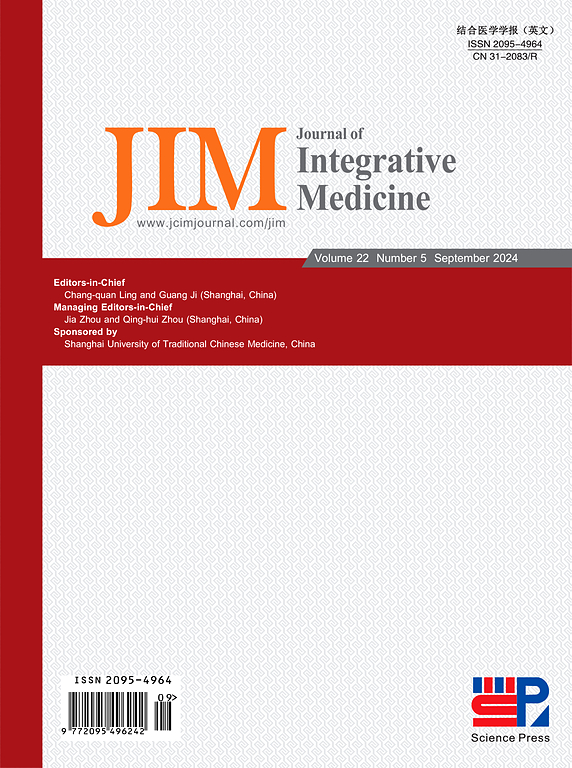Acupuncture at Weizhong (BL40) attenuates acetic acid-induced overactive bladder in rats by regulating brain neural activity through the modulation of mast cells and tibial nerves
IF 4
2区 医学
Q1 INTEGRATIVE & COMPLEMENTARY MEDICINE
引用次数: 0
Abstract
Objective
The present study evaluated the effects of deep acupuncture at Weizhong acupoint (BL40) on bladder function and brain activity in a rat model of overactive bladder (OAB), and investigated the possible mechanisms around the acupuncture area that initiate the effects of acupuncture.
Methods
Adult female Sprague–Dawley rats were randomly divided into six groups, comprising a control group, model group, group treated with deep acupuncture at BL40, group treated with shallow acupuncture at BL40, group treated with acupuncture at non-acupoint next to BL40, and group treated with acupuncture at Xuanzhong (GB39). Urodynamic evaluation was used to observe the urination, and functional magnetic resonance imaging was used to observe the brain activation. The mechanism of acupuncture at BL40 in regulating bladder function was explored by toluidine blue staining and enzyme-linked immunosorbent assay, and the mechanism was verified by stabilizing mast cells (MCs) or blocking tibial nerve.
Results
Deep acupuncture at BL40 significantly increased the intercontraction interval in OAB rats and enhanced the mean amplitude of low frequency fluctuation of primary motor cortex (M1), periaquaductal gray matter (PAG), and pontine micturition center (PMC). It also increased the zero-lag functional connectivity between M1 and PAG and between PAG and PMC. Shallow acupuncture at BL40 and acupuncture at non-acupoint or GB39 had no effect on these indexes. Further studies suggested that deep acupuncture at BL40 increased the number and degranulation rate of MCs as well as the contents of 5-hydroxytryptamine, substance P, and histamine in the tissues around BL40. Blocking the tibial nerve by lidocaine injection or inhibiting MC degranulation by sodium cromoglycate injection obstructed the effects of acupuncture on restoring urinary function and modulating brain activation in OAB rats.
Conclusion
Deep acupuncture at BL40 may be more effective for inhibiting OAB by promoting degranulation of MCs around the acupoint and stimulating tibial nerve, thereby regulating the activation of the brain area that controls the lower urinary tract.
Please cite this article as: Liu X, Zhang CY, Du XY, Li SS, Wang YQ, Zheng Y, Deng HZ, Fang XQ, Li JY, Wang ZQ, Xu SF, Mi YQ. Acupuncture at Weizhong (BL40) attenuates acetic acid-induced overactive bladder in rats by regulating brain neural activity through the modulation of mast cells and tibial nerves. J Integr Med. 2025; 23(1): 46–55.
针刺胃中穴(BL40)通过调节肥大细胞和胫神经调节脑神经活动,减轻醋酸所致大鼠膀胱过动症。
目的:观察深针刺胃中穴(BL40)对膀胱过动症(OAB)大鼠膀胱功能和脑活动的影响,并探讨针刺作用的可能机制。方法:将成年雌性Sprague-Dawley大鼠随机分为6组,分别为对照组、模型组、深层针刺BL40组、浅层针刺BL40组、非BL40邻近穴位针刺组、玄中针刺组(GB39)。尿动力学评价观察排尿情况,功能磁共振成像观察脑活化情况。采用甲苯胺蓝染色和酶联免疫吸附法探讨针刺BL40调节膀胱功能的机制,并通过稳定肥大细胞(肥大细胞)或阻断胫骨神经来验证其机制。结果:深针BL40明显增加OAB大鼠的间缩间隔,增强初级运动皮质(M1)、水导管周围灰质(PAG)和脑桥排尿中心(PMC)的低频波动平均幅度。它还增加了M1与PAG之间以及PAG与PMC之间的零滞后功能连接。浅针BL40、非穴位针刺或GB39对上述指标均无影响。进一步研究表明,在BL40处深针刺可增加BL40周围组织中MCs的数量和脱颗粒速度,以及5-羟色胺、P物质和组胺的含量。利多卡因阻断胫骨神经或氯甘酸钠抑制MC脱粒,均阻碍了针刺对OAB大鼠尿功能恢复和脑活化调节的作用。结论:深针刺BL40可能通过促进穴位周围MCs的脱颗粒,刺激胫骨神经,从而调节控制下尿路的脑区激活,从而更有效地抑制OAB。本文署名:刘鑫、张永英、杜晓霞、李世生、王永强、郑勇、邓海辉、方晓强、李建勇、王志强、徐顺生、米永强。针刺胃中穴(BL40)通过调节肥大细胞和胫神经调节脑神经活动,减轻醋酸所致大鼠膀胱过动症。集成医学[J];打印前Epub。
本文章由计算机程序翻译,如有差异,请以英文原文为准。
求助全文
约1分钟内获得全文
求助全文
来源期刊

Journal of Integrative Medicine-Jim
Medicine-Complementary and Alternative Medicine
CiteScore
9.20
自引率
4.20%
发文量
3319
期刊介绍:
The predecessor of JIM is the Journal of Chinese Integrative Medicine (Zhong Xi Yi Jie He Xue Bao). With this new, English-language publication, we are committed to make JIM an international platform for publishing high-quality papers on complementary and alternative medicine (CAM) and an open forum in which the different professions and international scholarly communities can exchange views, share research and their clinical experience, discuss CAM education, and confer about issues and problems in our various disciplines and in CAM as a whole in order to promote integrative medicine.
JIM is indexed/abstracted in: MEDLINE/PubMed, ScienceDirect, Emerging Sources Citation Index (ESCI), Scopus, Embase, Chemical Abstracts (CA), CAB Abstracts, EBSCO, WPRIM, JST China, Chinese Science Citation Database (CSCD), and China National Knowledge Infrastructure (CNKI).
JIM Editorial Office uses ThomsonReuters ScholarOne Manuscripts as submitting and review system (submission link: http://mc03.manuscriptcentral.com/jcim-en).
JIM is published bimonthly. Manuscripts submitted to JIM should be written in English. Article types include but are not limited to randomized controlled and pragmatic trials, translational and patient-centered effectiveness outcome studies, case series and reports, clinical trial protocols, preclinical and basic science studies, systematic reviews and meta-analyses, papers on methodology and CAM history or education, conference proceedings, editorials, commentaries, short communications, book reviews, and letters to the editor.
Our purpose is to publish a prestigious international journal for studies in integrative medicine. To achieve this aim, we seek to publish high-quality papers on any aspects of integrative medicine, such as acupuncture and traditional Chinese medicine, Ayurveda medicine, herbal medicine, homeopathy, nutrition, chiropractic, mind-body medicine, taichi, qigong, meditation, and any other modalities of CAM; our commitment to international scope ensures that research and progress from all regions of the world are widely covered. These ensure that articles published in JIM have the maximum exposure to the international scholarly community.
JIM can help its authors let their papers reach the widest possible range of readers, and let all those who share an interest in their research field be concerned with their study.
 求助内容:
求助内容: 应助结果提醒方式:
应助结果提醒方式:


